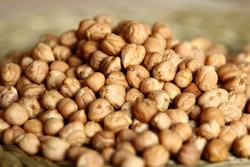Chickpeas Description & Health Benefits
 Chickpeas, otherwise known as garbanzo bean, are a member of the Fabaceae botanical family which also includes other beans such as fava, kidney, lima, and pinto. The Fabaceae botanical family also consists of green peas, peanut and soybean, to name a few.
Chickpeas, otherwise known as garbanzo bean, are a member of the Fabaceae botanical family which also includes other beans such as fava, kidney, lima, and pinto. The Fabaceae botanical family also consists of green peas, peanut and soybean, to name a few.- Chickpeas are an excellent source of fiber, folate, and manganese and a good source of protein, iron, magnesium, and phosphorus.
- Fiber improves digestive health and weight control while also protecting against colorectal cancer.
- Folate is needed to make DNA and other genetic material. Adequate folate intake reduces the risk of neural tube defects among pregnant women.
- Manganese aids the body in forming connective tissue and bones while it also assists with fat and carbohydrate metabolism, calcium absorption and blood sugar regulation.
- Protein is the building blocks of bones, muscles, cartilage, skin and blood. It’s also essential for growth and development.
- Iron is required for growth and development and it supports creation of red blood cells, hormones and connective tissue.
- Magnesium regulates muscle and nerve function, blood sugar levels and blood pressure.
- Phosphorus supports formation of bones and teeth and is required to make protein for growth, maintenance and repair of cells and tissues.
Purchasing, Selecting, Storing, and Preparing
- Purchase beans year round at a grocery store. Beans are available precooked in a can for easy and fast meal preparation. Ensure canned beans are within the recommended date of purchase. Some recipes call for beans to be rinsed before they are added to a dish.
- Beans are also available in their uncooked, dry form, prepackaged or found in the bulk section.
- Select dried beans that have an outer skin that is smooth and plump, and avoid those that are shriveled, broken or contain tiny pinholes.
- Store dried beans in an air tight container in a cool, dry place for up to one year.
- Various methods exist for preparing dried beans. First, remove any debris such as rocks or other foreign objects. Rinse beans in a colander under cold water. Soak beans by placing them in a large pot and add five cups of water for every one cup of beans. Bring beans and water to a boil and continue to boil for 2-3 minutes. Remove beans from heat, cover and let sit for 4-24 hours.
- For a faster option, let beans sit for one hour. Drain beans and discard water. Rinse beans with fresh water. Place beans back in the pot, cover with fresh water and bring to a simmer over medium heat. As beans expand, continue to add warm water occasionally to keep beans fully covered. Stir regularly to prevent sticking. Simmer beans for 30 minutes to two hours or until tender. Chickpeas typically take 1 ½ hours, but the timing of other varieties of beans can vary..
- Add cooked beans to salads, soups or grain dishes. Consider pureeing and making a bean dip. Find additional bean recipes at beaninstitute.com.
Nutrition Facts
Chickpeas, cooked & boiled, ½ cup serving
Calories: 134 | Protein: 7.27 g | Fat: 2.12 g | Carbohydrate: 22.48 g | Fiber: 6.2 g | Calcium: 40 mg | Iron: 2.37 mg | Magnesium: 39 mg | Potassium: 239 mg | Folate: 141 μg | Vitamin A: 22 IU
ndb.nal.usda.gov
Recipes
Request an Appointment
